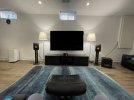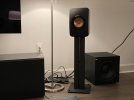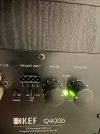SuicideSquid
Addicted to Fun and Learning
- Joined
- Jan 20, 2022
- Messages
- 700
- Likes
- 1,655
If you're also considering a speaker upgrade, forgo the amp entirely and buy active speakers.Hi Folks. I’m planning to upgrade my amplifier with my newly adopted “scientific” perspective.
Please first let me know if I understand this mindset correctly, and then help me choose an appropriate amp.
What this “scientific mindset” means to me is that instead of going after amps with warm, bright, good soundstage, bad soundstage with different “sound signature”, and still be worried about whether they would match my speakers; I choose a good solid, natural amp (with acceptable measurement) and then add my own EQ. This way any amp would match any speaker by tweaking EQ, hence, I make it warm, bright, wider soundstage, narrower soundstage, etc to my liking! Do I get this concept right?
If this assumption is correct then, let me find the best possible amp (before hitting the diminishing return)
My setup is as follows:
- Bluesound Node as Streamer
- RME ADI-2 as an EQ and Preamp
- Yamaha Integrated Amp (NR602) that will be replaced by the new amp
- KEF LS50 as speakers
- KEF Q400b as Sub
A few criteria:
- I don’t want to get into DIY, at this time, and prefer a commercially made reputable, solid, brand that hopefully has good residual value
- I have the following floor speakers in my pipe-line (B&W 702 S2, 803 D4, KEF Reference 3), so the amp should be capable of handling it on its own, or alternatively can be bridged with its sibling (when I upgraded the speakers) to function as a mono-block.
- My speakers said it to be non-efficient so, I was told that I should get a with high current. How can I determine that an amp has a high current?
- I live in Canada
A few uncertainties:
- If I use RME ADI-2 as my pre-amp can I get the most of my amp quality? Or do I lose in quality in compassion by adding another pre-amp? (I only stream so I don’t need phono, line in, etc)
- can I connect my sub to the amp if the amp doesn’t have sub input? In that case, is it safe to do so?
- based on the abuse mindset can I be sure no matter what amp I get, as long as it meets the measurement criteria, will sound good to my speaker just after tweaking the EQ, so I could buy it without even auditioning it?
- do you think this upgrade would have a noticeable impact, as compared to my current amp?
Candidates:
To the best of my research, my good candidate here is NAD C298. People in this forum talk about it. They say it has Purifi, and I suppose it should sound good, I don’t know much about this. Another alternative is Benchmark, or PS Audio?
I don’t want to overspend but I can go as high as needed to get something “for life”
I’m open to your suggestions and perspective.
In a small or medium-sized room, my $1500 Dynaudio Lyd-7 active speakers give my $4,000 Totem Forests connected to $3,000 in amplification a run for their money, at 1/4 the cost. Neumann KH-310 speakers are the best I've ever heard. You can get them for about $5,000 for a pair at Long & McQuade in Canada - a lot less than you'd pay for that NAD amplifier and a pair of B&W floorstanding speakers - and they'll mop the floor with the B&Ws in every respect except maybe maximum output.



